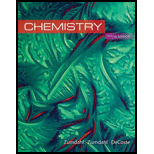
Concept explainers
(a)
Interpretation: The effect on temperature on the stretching of rubber band is to be stated and whether the stretching is an exothermic or endothermic process is to be explained in terms of intermolecular forces. Also, the sign of
Concept introduction: Rubber is a
To determine: The effect on temperature on the stretching of rubber band.
(b)
Interpretation: The effect on temperature on the stretching of rubber band is to be stated and whether the stretching is an exothermic or endothermic process is to be explained in terms of intermolecular forces. Also, the sign of
Concept introduction: Rubber is a polymer (long chain molecules) made from organic compound isoprene. The molecules in rubber are arranged in a tangled up position than an aligned position and due to thermal motion they lose their alignment and go back to their tangled state and this is called an elastic contact caused by an entropic force.
To determine: The stretching is an exothermic or endothermic process.
(c)
Interpretation: The effect on temperature on the stretching of rubber band is to be stated and whether the stretching is an exothermic or endothermic process is to be explained in terms of intermolecular forces. Also, the sign of
Concept introduction: Rubber is a polymer (long chain molecules) made from organic compound isoprene. The molecules in rubber are arranged in a tangled up position than an aligned position and due to thermal motion they lose their alignment and go back to their tangled state and this is called an elastic contact caused by an entropic force.
To determine: The above results in terms of intermolecular forces.
(d)
Interpretation: The effect on temperature on the stretching of rubber band is to be stated and whether the stretching is an exothermic or endothermic process is to be explained in terms of intermolecular forces. Also, the sign of
Concept introduction: Rubber is a polymer (long chain molecules) made from organic compound isoprene. The molecules in rubber are arranged in a tangled up position than an aligned position and due to thermal motion they lose their alignment and go back to their tangled state and this is called an elastic contact caused by an entropic force.
To determine: The sign of
(e)
Interpretation: The effect on temperature on the stretching of rubber band is to be stated and whether the stretching is an exothermic or endothermic process is to be explained in terms of intermolecular forces. Also, the sign of
Concept introduction: Rubber is a polymer (long chain molecules) made from organic compound isoprene. The molecules in rubber are arranged in a tangled up position than an aligned position and due to thermal motion they lose their alignment and go back to their tangled state and this is called an elastic contact caused by an entropic force.
To determine: The molecular explanation for the sign of
Want to see the full answer?
Check out a sample textbook solution
Chapter 22 Solutions
Chemistry
- Identify the compound with the longest carbon - nitrogen bond. O CH3CH2CH=NH O CH3CH2NH2 CH3CH2C=N CH3CH=NCH 3 The length of all the carbon-nitrogen bonds are the samearrow_forwardIdentify any polar covalent bonds in epichlorohydrin with S+ and 8- symbols in the appropriate locations. Choose the correct answer below. Η H's+ 6Η Η Η Η Η Ηδ Η Ο Ο HH +Η Η +Η Η Η -8+ CIarrow_forwardH H:O::::H H H HH H::O:D:D:H HH HH H:O:D:D:H .. HH H:O:D:D:H H H Select the correct Lewis dot structure for the following compound: CH3CH2OHarrow_forward
- Rank the following compounds in order of decreasing boiling point. ннннн -С-С-Н . н-с- ННННН H ΗΤΗ НННН TTTĪ н-с-с-с-с-о-н НННН НН C' Н н-с-с-с-с-н НН || Ш НННН H-C-C-C-C-N-H ННННН IVarrow_forwardRank the following compounds in order of decreasing dipole moment. |>||>||| ||>|||>| |>|||>|| |||>||>| O ||>>||| H F H F H c=c || H c=c F F IIIarrow_forwardchoose the description that best describes the geometry for the following charged species ch3-arrow_forward
- Why isn't the ketone in this compound converted to an acetal or hemiacetal by the alcohol and acid?arrow_forwardWhat is the approximate bond angle around the nitrogen atom? HNH H Harrow_forwardOH 1. NaOCH2CH3 Q 2. CH3CH2Br (1 equiv) H3O+ Select to Draw 1. NaOCH2 CH3 2. CH3Br (1 equiv) heat Select to Edit Select to Drawarrow_forward
- Complete and balance the following half-reaction in acidic solution. Be sure to include the proper phases for all species within the reaction. S₂O₃²⁻(aq) → S₄O₆²⁻(aq)arrow_forwardQ Select to Edit NH3 (CH3)2CHCI (1 equiv) AICI 3 Select to Draw cat. H2SO4 SO3 (1 equiv) HO SOCl2 pyridine Select to Edit >arrow_forwardComplete and balance the following half-reaction in basic solution. Be sure to include the proper phases for all species within the reaction. Zn(s) → Zn(OH)₄²⁻(aq)arrow_forward
 ChemistryChemistryISBN:9781305957404Author:Steven S. Zumdahl, Susan A. Zumdahl, Donald J. DeCostePublisher:Cengage Learning
ChemistryChemistryISBN:9781305957404Author:Steven S. Zumdahl, Susan A. Zumdahl, Donald J. DeCostePublisher:Cengage Learning Chemistry: An Atoms First ApproachChemistryISBN:9781305079243Author:Steven S. Zumdahl, Susan A. ZumdahlPublisher:Cengage Learning
Chemistry: An Atoms First ApproachChemistryISBN:9781305079243Author:Steven S. Zumdahl, Susan A. ZumdahlPublisher:Cengage Learning
 Introductory Chemistry: A FoundationChemistryISBN:9781337399425Author:Steven S. Zumdahl, Donald J. DeCostePublisher:Cengage Learning
Introductory Chemistry: A FoundationChemistryISBN:9781337399425Author:Steven S. Zumdahl, Donald J. DeCostePublisher:Cengage Learning Introductory Chemistry: An Active Learning Approa...ChemistryISBN:9781305079250Author:Mark S. Cracolice, Ed PetersPublisher:Cengage Learning
Introductory Chemistry: An Active Learning Approa...ChemistryISBN:9781305079250Author:Mark S. Cracolice, Ed PetersPublisher:Cengage Learning Chemistry In FocusChemistryISBN:9781305084476Author:Tro, Nivaldo J., Neu, Don.Publisher:Cengage Learning
Chemistry In FocusChemistryISBN:9781305084476Author:Tro, Nivaldo J., Neu, Don.Publisher:Cengage Learning





